Engine LINCOLN LS 2002 Owners Manual
[x] Cancel search | Manufacturer: LINCOLN, Model Year: 2002, Model line: LS, Model: LINCOLN LS 2002Pages: 288, PDF Size: 2.44 MB
Page 266 of 288
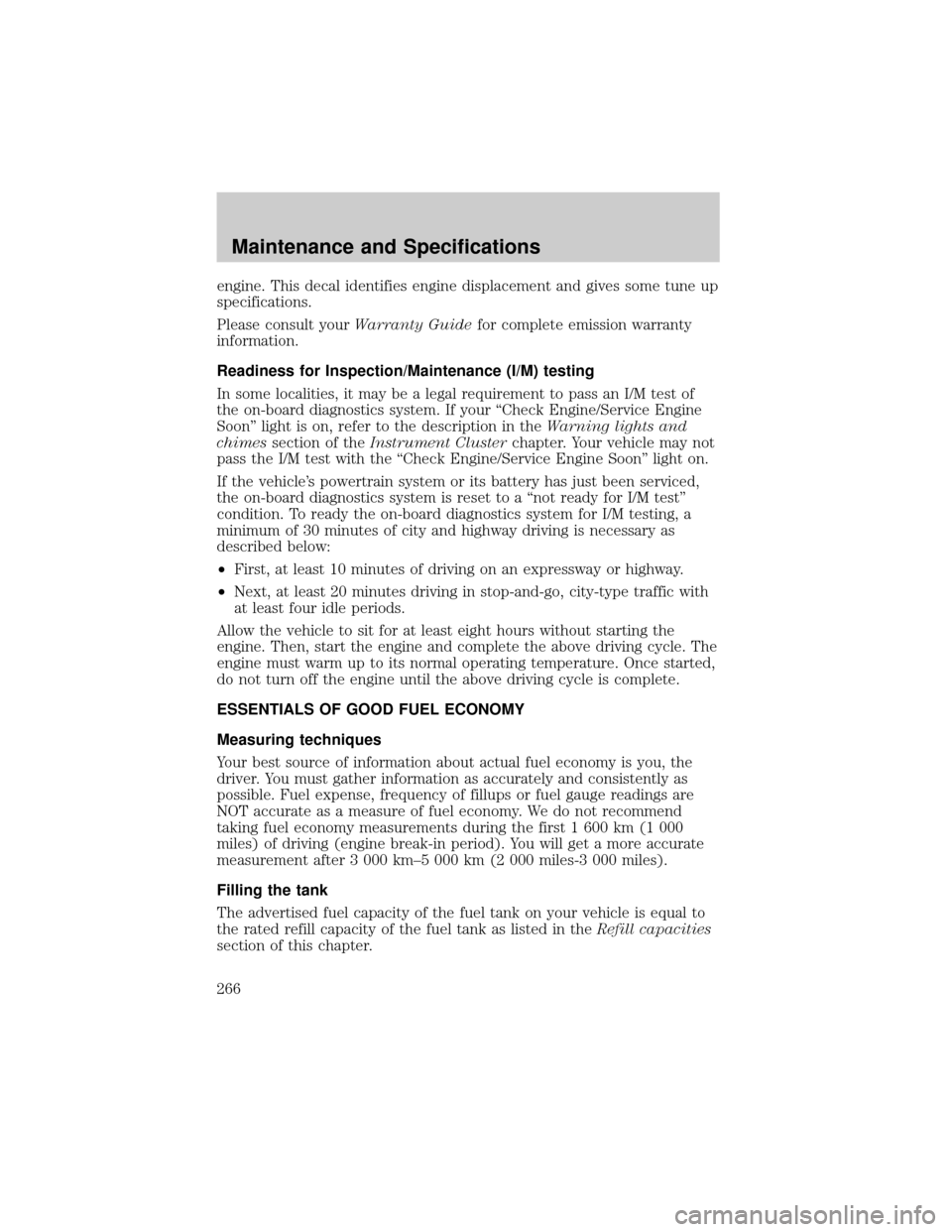
engine. This decal identifies engine displacement and gives some tune up
specifications.
Please consult yourWarranty Guidefor complete emission warranty
information.
Readiness for Inspection/Maintenance (I/M) testing
In some localities, it may be a legal requirement to pass an I/M test of
the on-board diagnostics system. If your ªCheck Engine/Service Engine
Soonº light is on, refer to the description in theWarning lights and
chimessection of theInstrument Clusterchapter. Your vehicle may not
pass the I/M test with the ªCheck Engine/Service Engine Soonº light on.
If the vehicle's powertrain system or its battery has just been serviced,
the on-board diagnostics system is reset to a ªnot ready for I/M testº
condition. To ready the on-board diagnostics system for I/M testing, a
minimum of 30 minutes of city and highway driving is necessary as
described below:
²First, at least 10 minutes of driving on an expressway or highway.
²Next, at least 20 minutes driving in stop-and-go, city-type traffic with
at least four idle periods.
Allow the vehicle to sit for at least eight hours without starting the
engine. Then, start the engine and complete the above driving cycle. The
engine must warm up to its normal operating temperature. Once started,
do not turn off the engine until the above driving cycle is complete.
ESSENTIALS OF GOOD FUEL ECONOMY
Measuring techniques
Your best source of information about actual fuel economy is you, the
driver. You must gather information as accurately and consistently as
possible. Fuel expense, frequency of fillups or fuel gauge readings are
NOT accurate as a measure of fuel economy. We do not recommend
taking fuel economy measurements during the first 1 600 km (1 000
miles) of driving (engine break-in period). You will get a more accurate
measurement after 3 000 km±5 000 km (2 000 miles-3 000 miles).
Filling the tank
The advertised fuel capacity of the fuel tank on your vehicle is equal to
the rated refill capacity of the fuel tank as listed in theRefill capacities
section of this chapter.
Maintenance and Specifications
266
Page 267 of 288
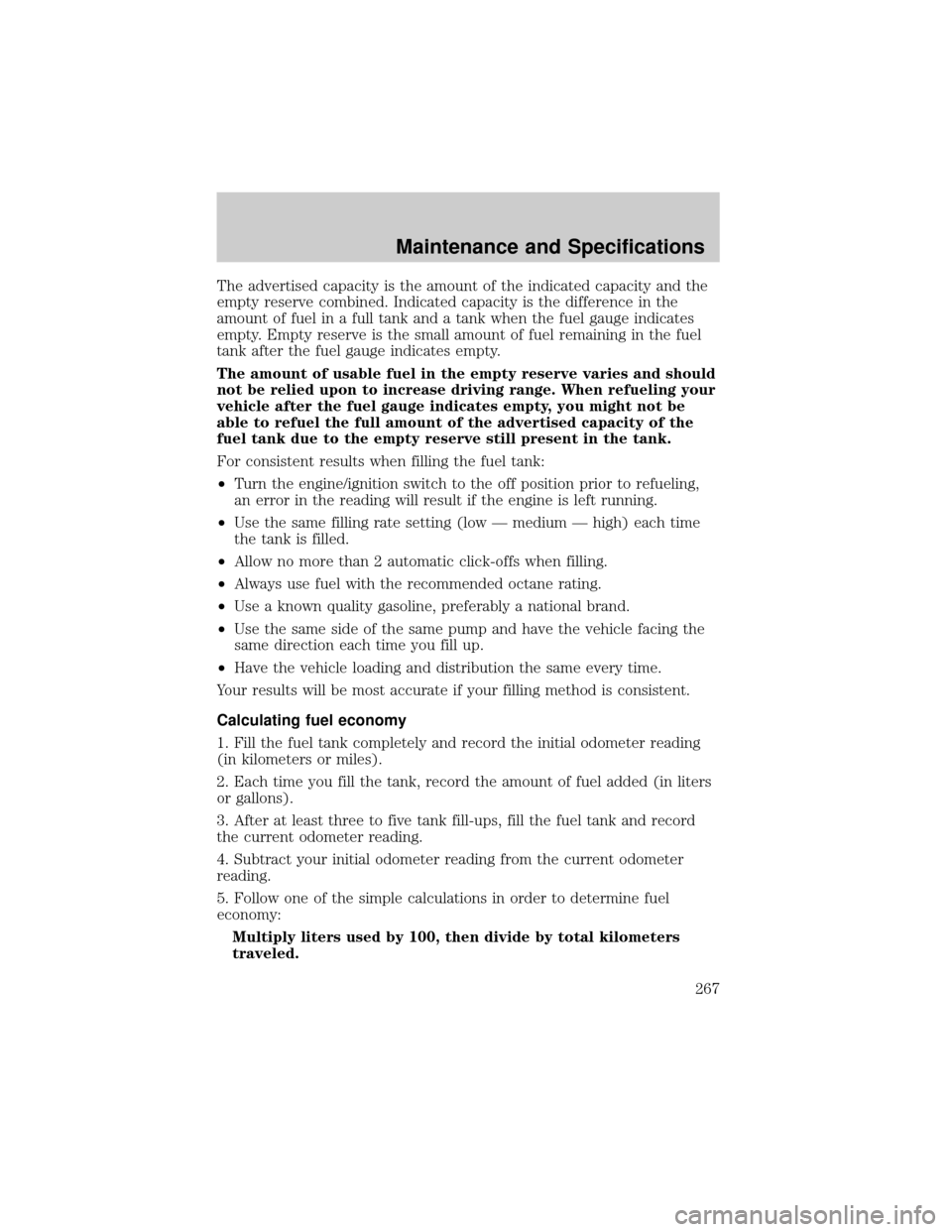
The advertised capacity is the amount of the indicated capacity and the
empty reserve combined. Indicated capacity is the difference in the
amount of fuel in a full tank and a tank when the fuel gauge indicates
empty. Empty reserve is the small amount of fuel remaining in the fuel
tank after the fuel gauge indicates empty.
The amount of usable fuel in the empty reserve varies and should
not be relied upon to increase driving range. When refueling your
vehicle after the fuel gauge indicates empty, you might not be
able to refuel the full amount of the advertised capacity of the
fuel tank due to the empty reserve still present in the tank.
For consistent results when filling the fuel tank:
²Turn the engine/ignition switch to the off position prior to refueling,
an error in the reading will result if the engine is left running.
²Use the same filling rate setting (low Ð medium Ð high) each time
the tank is filled.
²Allow no more than 2 automatic click-offs when filling.
²Always use fuel with the recommended octane rating.
²Use a known quality gasoline, preferably a national brand.
²Use the same side of the same pump and have the vehicle facing the
same direction each time you fill up.
²Have the vehicle loading and distribution the same every time.
Your results will be most accurate if your filling method is consistent.
Calculating fuel economy
1. Fill the fuel tank completely and record the initial odometer reading
(in kilometers or miles).
2. Each time you fill the tank, record the amount of fuel added (in liters
or gallons).
3. After at least three to five tank fill-ups, fill the fuel tank and record
the current odometer reading.
4. Subtract your initial odometer reading from the current odometer
reading.
5. Follow one of the simple calculations in order to determine fuel
economy:
Multiply liters used by 100, then divide by total kilometers
traveled.
Maintenance and Specifications
267
Page 268 of 288
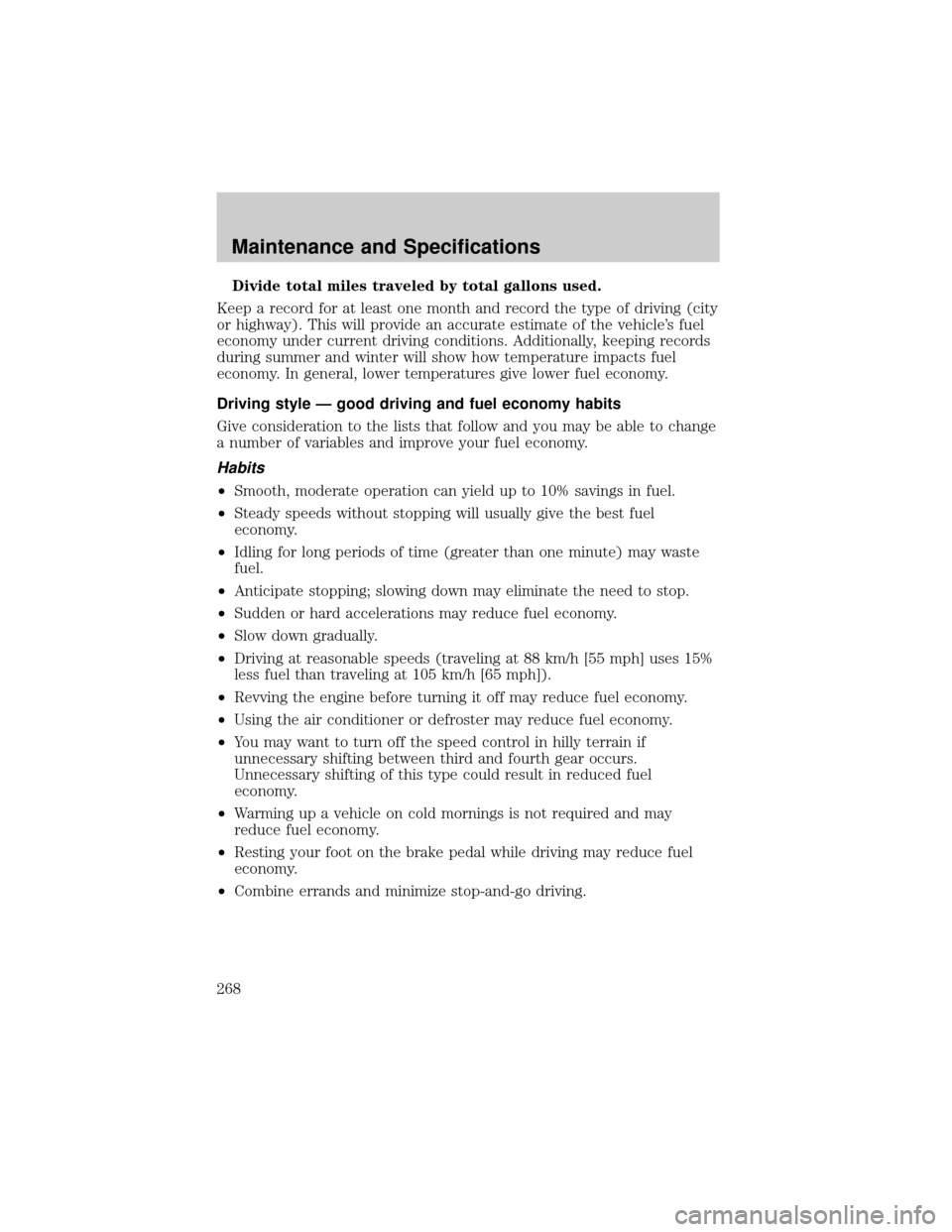
Divide total miles traveled by total gallons used.
Keep a record for at least one month and record the type of driving (city
or highway). This will provide an accurate estimate of the vehicle's fuel
economy under current driving conditions. Additionally, keeping records
during summer and winter will show how temperature impacts fuel
economy. In general, lower temperatures give lower fuel economy.
Driving style Ð good driving and fuel economy habits
Give consideration to the lists that follow and you may be able to change
a number of variables and improve your fuel economy.
Habits
²Smooth, moderate operation can yield up to 10% savings in fuel.
²Steady speeds without stopping will usually give the best fuel
economy.
²Idling for long periods of time (greater than one minute) may waste
fuel.
²Anticipate stopping; slowing down may eliminate the need to stop.
²Sudden or hard accelerations may reduce fuel economy.
²Slow down gradually.
²Driving at reasonable speeds (traveling at 88 km/h [55 mph] uses 15%
less fuel than traveling at 105 km/h [65 mph]).
²Revving the engine before turning it off may reduce fuel economy.
²Using the air conditioner or defroster may reduce fuel economy.
²You may want to turn off the speed control in hilly terrain if
unnecessary shifting between third and fourth gear occurs.
Unnecessary shifting of this type could result in reduced fuel
economy.
²Warming up a vehicle on cold mornings is not required and may
reduce fuel economy.
²Resting your foot on the brake pedal while driving may reduce fuel
economy.
²Combine errands and minimize stop-and-go driving.
Maintenance and Specifications
268
Page 269 of 288
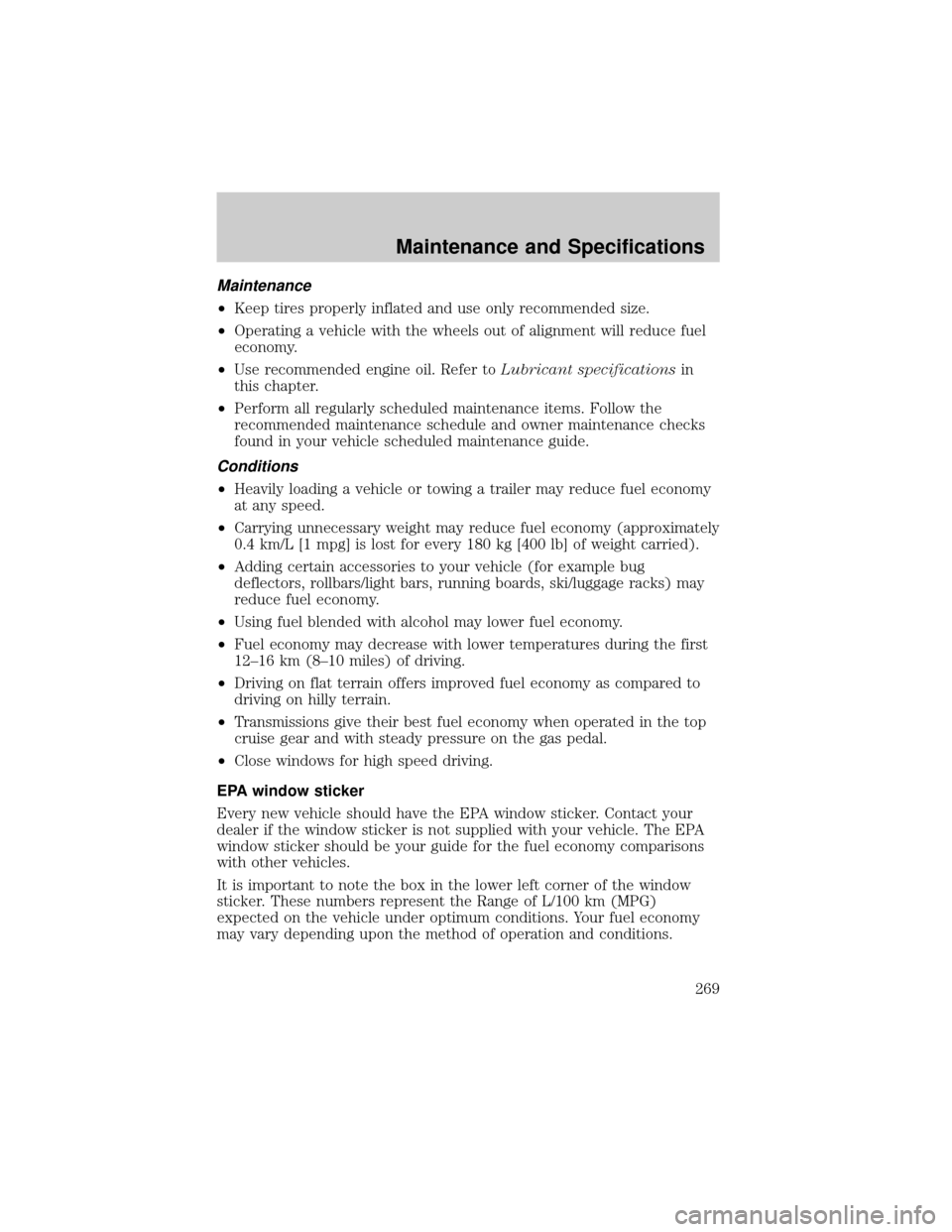
Maintenance
²Keep tires properly inflated and use only recommended size.
²Operating a vehicle with the wheels out of alignment will reduce fuel
economy.
²Use recommended engine oil. Refer toLubricant specificationsin
this chapter.
²Perform all regularly scheduled maintenance items. Follow the
recommended maintenance schedule and owner maintenance checks
found in your vehicle scheduled maintenance guide.
Conditions
²Heavily loading a vehicle or towing a trailer may reduce fuel economy
at any speed.
²Carrying unnecessary weight may reduce fuel economy (approximately
0.4 km/L [1 mpg] is lost for every 180 kg [400 lb] of weight carried).
²Adding certain accessories to your vehicle (for example bug
deflectors, rollbars/light bars, running boards, ski/luggage racks) may
reduce fuel economy.
²Using fuel blended with alcohol may lower fuel economy.
²Fuel economy may decrease with lower temperatures during the first
12±16 km (8±10 miles) of driving.
²Driving on flat terrain offers improved fuel economy as compared to
driving on hilly terrain.
²Transmissions give their best fuel economy when operated in the top
cruise gear and with steady pressure on the gas pedal.
²Close windows for high speed driving.
EPA window sticker
Every new vehicle should have the EPA window sticker. Contact your
dealer if the window sticker is not supplied with your vehicle. The EPA
window sticker should be your guide for the fuel economy comparisons
with other vehicles.
It is important to note the box in the lower left corner of the window
sticker. These numbers represent the Range of L/100 km (MPG)
expected on the vehicle under optimum conditions. Your fuel economy
may vary depending upon the method of operation and conditions.
Maintenance and Specifications
269
Page 272 of 288
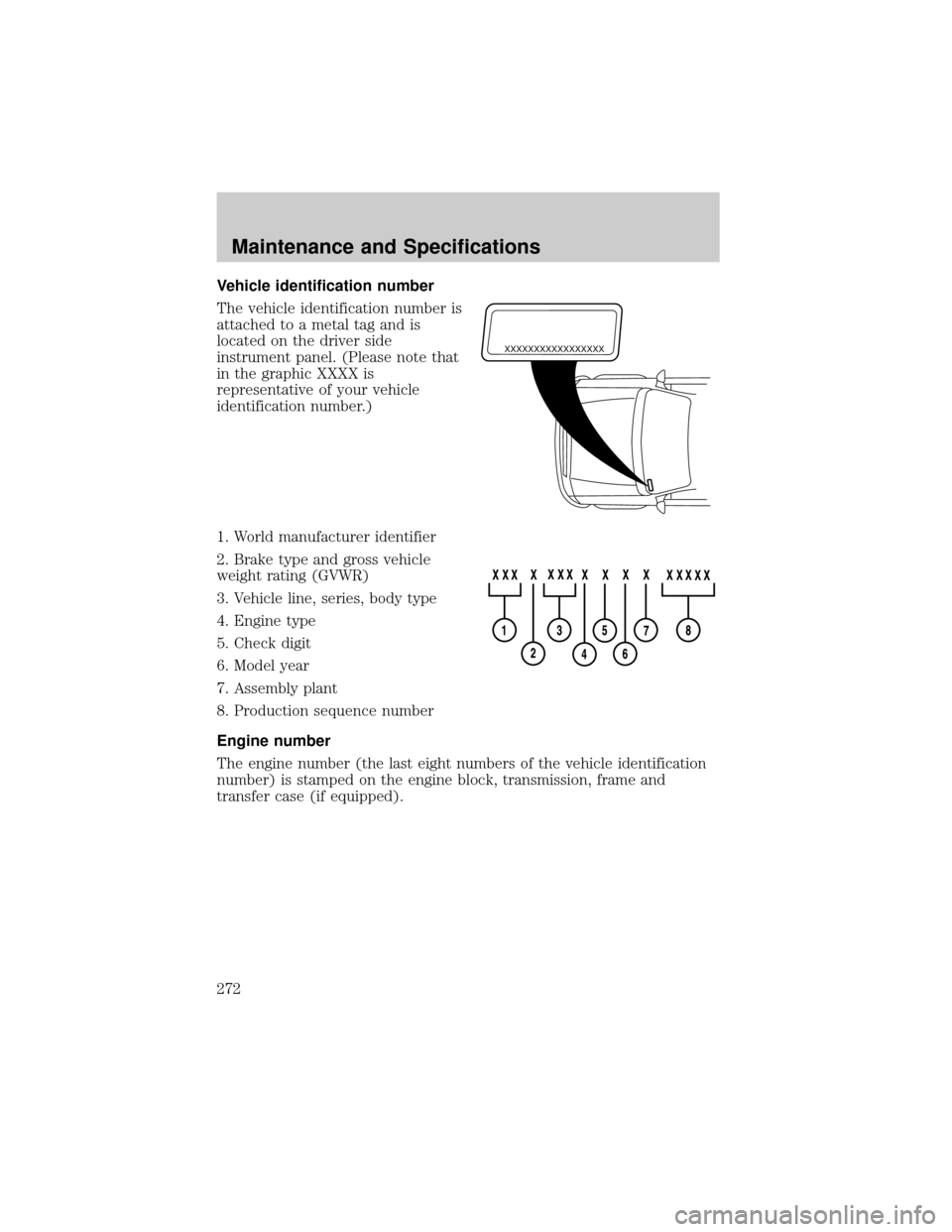
Vehicle identification number
The vehicle identification number is
attached to a metal tag and is
located on the driver side
instrument panel. (Please note that
in the graphic XXXX is
representative of your vehicle
identification number.)
1. World manufacturer identifier
2. Brake type and gross vehicle
weight rating (GVWR)
3. Vehicle line, series, body type
4. Engine type
5. Check digit
6. Model year
7. Assembly plant
8. Production sequence number
Engine number
The engine number (the last eight numbers of the vehicle identification
number) is stamped on the engine block, transmission, frame and
transfer case (if equipped).
XXXXXXXXXXXXXXXXX
Maintenance and Specifications
272
Page 273 of 288

FORD ACCESSORIES FOR YOUR VEHICLE
A wide selection of genuine Ford accessories are available for your
vehicle through your local authorized Lincoln Mercury dealer. These
quality accessories have been specifically engineered to fulfill your
automotive needs; they are custom designed to complement the style
and aerodynamic appearance of your vehicle. In addition, each accessory
is made from high quality materials and meets or exceeds Ford's rigorous
engineering and safety specifications. Ford Motor Company will repair or
replace any properly dealer-installed Ford accessory found to be
defective in factory-supplied materials or workmanship during the
warranty period, as well as any component damaged by the defective
accessory. The accessory will be warranted for whichever provides you
the greatest benefit:
²12 months or 20 000 km (12 000 miles) (whichever occurs first), or
²The remainder of your new vehicle limited warranty.
This means that genuine Ford accessories purchased along with your
new vehicle and installed by the dealer are covered for the full length of
your New Vehicle's Limited Warranty Ð 3 years or 60 000 km (36 000
miles) (whichever occurs first). Contact your dealer for details and a
copy of the warranty.
Not all accessories are available for all models.
Vehicle Security
Remote start
Styled wheel locks
Vehicle security systems
Comfort and convenience
Cargo nets
Cargo organizers (trunk)
Cargo tray
Electrochromic compass inside mirror
Engine block heaters
Luggage/cargo basket
Manual gear shift knob (woodgrain)
Remote start system
Accessories
273
Page 275 of 288

²The Federal Communications Commission (FCC) and Canadian Radio
Telecommunications Commission (CRTC) regulate the use of mobile
communications systems - such as two-way radios, telephones and
theft alarms - that are equipped with radio transmitters. Any such
equipment installed in your vehicle should comply with FCC or CRTC
regulations and should be installed only by a qualified service
technician.
²Mobile communications systems may harm the operation of your
vehicle, particularly if they are not properly designed for automotive
use or are not properly installed. When operated, such systems may
cause the engine to stumble or stall or cause the transmission to be
damaged or operate improperly. In addition, such systems may be
damaged or their performance may be affected by operating your
vehicle. (Citizens band [CB] transceivers, garage door openers and
other transmitters with outputs of five watts or less will not ordinarily
affect your vehicle's operation.)
²Ford cannot assume responsibility for any adverse affects or damage
that may result from the use of such equipment.
Accessories
275
Page 276 of 288

A
Accessory delay ..........................74
AdvanceTrac ..............................165
Air bag supplemental
restraint system ................139, 143
and child safety seats ............141
description ......................139, 143
disposal ....................................146
driver air bag ..................141, 144
indicator light ...........12, 143, 145
operation .........................141, 144
passenger air bag ...........141, 144
side air bag ..............................143
Air cleaner filter .......253±254, 261
Air conditioning ..........................48
Air filter, cabin ............................59
Antifreeze
(see Engine coolant) ................237
Anti-lock brake system
(see Brakes) ..............................161
Anti-theft system ......................120
arming the system ..................120
disarming a triggered
system .....................................120
Audio system (see Radio) .........31
Automatic transmission ............167
driving an automatic
overdrive .................................168
fluid, adding ............................252
fluid, checking ........................252
fluid, refill capacities ..............261
fluid, specification ..................264
Axle
lubricant specifications ..263±264
refill capacities ........................261B
Battery .......................................235
acid, treating
emergencies ............................235
charging system
warning light .............................12
jumping a disabled battery ....202
maintenance-free ....................235
replacement, specifications ...261
servicing ..................................235
Belt minder ...............................134
Brakes ........................................160
anti-lock ...................................161
anti-lock brake system
(ABS) warning light .........12, 162
brake warning light ..................11
fluid, checking and adding ....251
fluid, refill capacities ..............261
fluid, specifications .........263±264
lubricant
specifications ..................263±264
parking ....................................162
shift interlock ..........................167
Break-in period .............................6
C
Capacities for refilling fluids ....261
Cargo net ...................................107
Cassette tape player ...................31
CD changer .................................44
Certification Label ....................271
Child safety restraints ..............147
child safety belts ....................147
Child safety seats ......................148
attaching with tether
straps .......................................152
Index
276
Page 277 of 288

in front seat ............................149
in rear seat ..............................149
Cleaning your vehicle
engine compartment ..............222
exterior ....................................226
instrument cluster lens ..........225
instrument panel ....................224
interior .....................................225
plastic parts ....................223±224
safety belts ..............................226
washing ....................................220
waxing .....................................220
wheels ......................................221
windows ..................................226
wiper blades ............................224
Clock ......................................24, 36
Clutch
fluid ..........................................253
operation while driving ..........177
recommended shift speeds ....178
Compass, electronic ..............74±75
calibration .................................77
set zone adjustment .................76
Console ......................................106
Controls
power seat ...............................123
steering column ........................84
Coolant
checking and adding ..............237
coolant temperature light ........13
refill capacities ................241, 261
specifications ..................263±264
Cruise control
(see Speed control) ....................78
Customer Assistance ................187
Ford accessories for your
vehicle .....................................227Ford Extended
Service Plan ............................212
Getting assistance outside
the U.S. and Canada ..............216
Getting roadside assistance ...187
Getting the service
you need .................................210
Ordering additional
owner's literature ...................217
The Dispute Settlement
Board .......................................213
Utilizing the Mediation/
Arbitration Program ...............216
D
Daytime running lamps
(see Lamps) ................................61
Defrost
rear window ..............................59
Dipstick
automatic transmission
fluid ..........................................252
engine oil .................................232
Doors
central unlocking ....................109
door ajar warning .....................15
lubricant specifications ..........263
Driving under special
conditions
through water .........................181
Dual automatic temperature
control (DATC) ...........................48
E
Emergencies, roadside
jump-starting ..........................202
Emission control system ..........265
Index
277
Page 278 of 288

Engine ................................264±265
check engine/service
engine soon light ......................10
cleaning ...................................222
coolant .....................................237
fail-safe coolant ......................242
idle speed control ...................235
lubrication specifications 263±264
refill capacities ........................261
service points ..................230±231
starting after a collision .........189
Engine block heater .................159
Engine fan .................................244
Engine oil ..................................232
checking and adding ..............232
dipstick ....................................232
filter, specifications ........234, 261
recommendations ...................234
refill capacities ........................261
specifications ..................263±264
Exhaust fumes ..........................159
F
Fail safe cooling ........................242
Floor mats .................................107
Fluid capacities .........................261
Foglamps .....................................61
Fuel ............................................245
calculating fuel
economy ............................96, 266
cap .....................................11, 247
capacity ...................................261
choosing the right fuel ...........248
comparisons with EPA
fuel economy estimates .........269
detergent in fuel .....................249
filling your vehicle
with fuel ..................245, 247, 266filter, specifications ........250, 261
fuel pump shut-off switch .....189
gauge .........................................17
improving fuel economy ........266
low fuel warning light ..............14
octane rating ...........248, 264±265
quality ......................................249
running out of fuel .................249
safety information relating
to automotive fuels ................245
Fuses ..................................190±191
G
Garage door opener ....................86
Gas cap (see Fuel cap) ......11, 247
Gas mileage (see Fuel
economy) ...................................266
Gauges .........................................16
engine coolant temperature
gauge .........................................16
fuel gauge ..................................17
odometer ...................................17
speedometer .............................17
tachometer ................................18
trip odometer ............................17
GAWR (Gross Axle Weight
Rating) .......................................181
definition .................................181
driving with a heavy load ......181
location ....................................181
GVWR (Gross Vehicle Weight
Rating) .......................................181
calculating ...............................181
definition .................................181
driving with a heavy load ......181
location ....................................181
Index
278